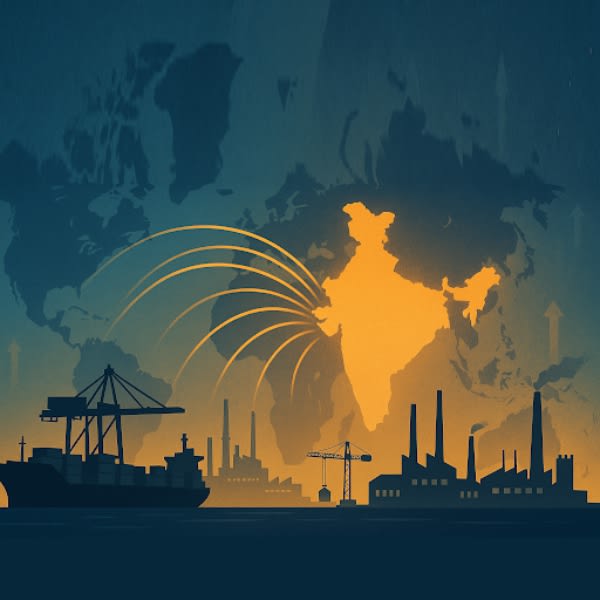India-US Relations: Strategic Patience or Weakness in the Face of Economic Pressure?
Exploring whether India’s balanced approach toward the U.S. reflects strategic patience or vulnerability under global economic challenges.

Exploring whether India’s balanced approach toward the U.S. reflects strategic patience or vulnerability under global economic challenges.
PART 2: The Counter-Strategy
Recap from Part 1:
In the first installment, we examined the escalating US economic offensive against India—from 50% combined tariffs on exports to the $100,000 H-1B visa fee targeting Indian tech professionals, Washington's ultimatum demanding India cease all Russian oil purchases, and sanctions on Iran's Chabahar Port. We explored why critics who see Modi's measured response as weakness fundamentally misunderstand the economic asymmetry at play: while the US is India's largest export destination, India's exports to America constitute only 2% of GDP, providing strategic flexibility that smaller economies lack.
India's Strategic Counter-Response: Economic Jujitsu
Rather than engaging in tit-for-tat retaliation that would likely harm Indian interests more than American ones, Modi's administration has pursued what military strategists call "asymmetric response"—measures that address vulnerabilities while building long-term strength.
The Production Linked Incentive (PLI) scheme represents perhaps the most significant element of this strategy. With committed investments of ₹1.76 trillion ($20.3 billion) across 14 sectors, generating over ₹16.5 trillion ($190.9 billion) in production and sales output, the PLI initiative is fundamentally reshaping India's manufacturing landscape.
The transformation is particularly evident in pharmaceuticals, where India has shifted from being a net importer of bulk drugs worth ₹19.3 billion in FY 2021-22 to a net exporter recording ₹22.8 billion in exports by FY 2024-25. In electronics manufacturing, the results are even more dramatic: mobile device production increased by 146%, rising from ₹2.13 trillion in FY 2020-21 to ₹5.25 trillion in FY 2024-25, while mobile phone exports surged eight-fold from ₹228.70 billion to ₹2 trillion.
This approach embodies Miguel de Cervantes timeless wisdom: Don't put all your eggs in one basket. India is systematically reducing its vulnerability to economic coercion by any single power, ironically serving American interests in supply chain diversification while strengthening its own strategic autonomy.
Building Alternative Partnerships
Simultaneously, India has accelerated its trade diversification strategy through strategic agreements. The India-UAE Comprehensive Economic Partnership Agreement (2022) and the India-Australia Economic Cooperation and Trade Agreement (2022) have opened new markets and reduced dependence on American consumers. The recently concluded India-UK agreement grants India duty-free access on 99% of its export tariff lines to the UK, providing substantial relief for textiles, agriculture, marine products, and engineering goods.
More strategically significant is India's engagement with the Eurasian Economic Union (EAEU), formalized through Terms of Reference signed in Moscow in August 2025 and got into effect from 1st October 2025. With bilateral trade st between India and the EAEU reaching $69 billion in 2024, this partnership offers substantial market diversification away from Western markets while sending a clear message about India's strategic autonomy.
The Case for Measured Pushback
Yet there comes a point when silence risks being mistaken for weakness—and that point may have arrived. While India's structural reforms and diversification strategy demonstrate strategic thinking, they need to be complemented by calibrated deterrence.
India could consider imposing stricter controls on American imports in select sectors, making it clear that pressure will invite reciprocal costs.
The government should aggressively promote Indian firms developing alternatives to American technology products, framed not as retaliation but as India's natural evolution toward technological sovereignty.
Public messaging also requires refinement. India should use every forum—from multilateral summits to domestic debates—to make its red lines clear, especially on energy security. These are not acts of hostility but acts of sovereignty.
Indian opposition parties paradox
The opposition’s and intellectuals call for stronger retaliation against the US essentially argue for policies that would likely harm India's economic interests—highlighting the gap between electoral politics and strategic governance.
Diplomatic Sophistication in Action
Modi's recent diplomatic engagements demonstrate sophisticated messaging that combines firmness with openness to dialogue. During Commerce Minister Piyush Goyal's visit to Washington in September 2025, India conveyed willingness to increase energy trade with the United States while simultaneously clarifying that any reduction in Russian oil imports would require American permission for purchases from Iran and Venezuela.
This position effectively calls Washington's bluff on energy diversification while highlighting American inconsistencies in sanctions policy. External Affairs Minister S. Jaishankar assertion that our priority is energy security, and we will continue to source energy from whichever nation serves our interests represents principled realpolitik rather than weakness.
The Technology Imperative
One area where India must indeed accelerate its response is technology independence. The success of India's UPI payment system and the growing strength of companies like Infosys, TCS, and emerging startups in AI and fintech demonstrate that technological sovereignty initiatives can succeed.
However, this technological push should be framed as India's natural evolution rather than retaliation against the US—a narrative that resonates domestically without unnecessarily antagonizing Washington.
→ Coming in Part 3: India's multi-pronged strategy reveals a nation playing the long game—but will strategic patience ultimately prove to be strategic wisdom? In the final installment, we examine what Trump's escalating threats mean for the future of this critical relationship, and why the true test of Modi's leadership may lie not in how loudly India protests, but in how effectively it builds the architecture of independence.
- Analysis of geopolitical and finance topics